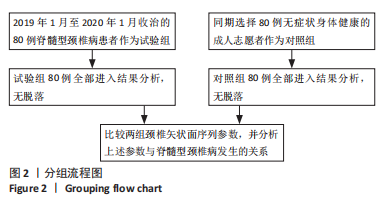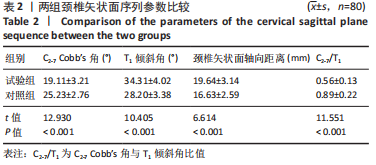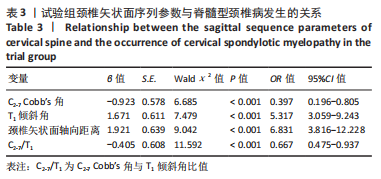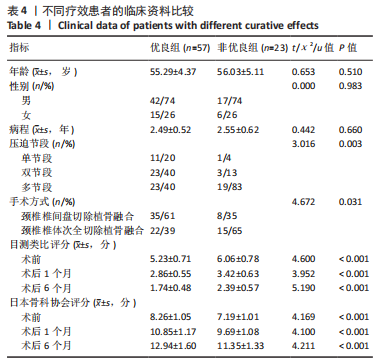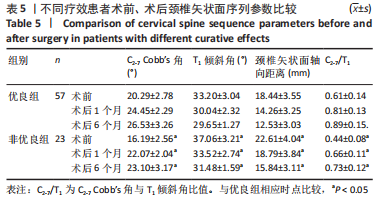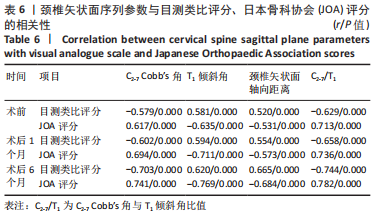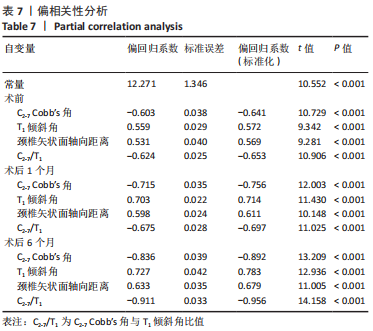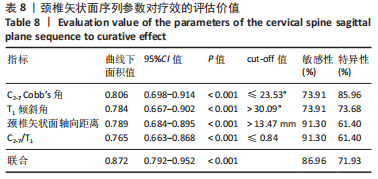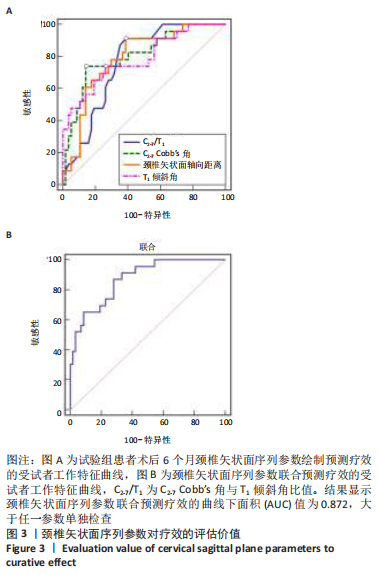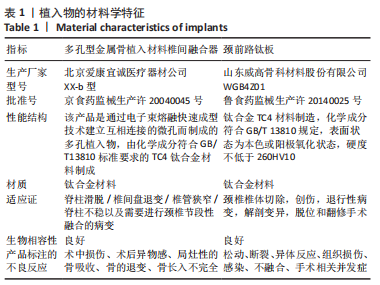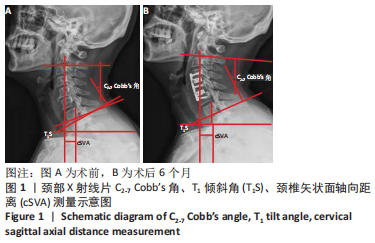中国组织工程研究 ›› 2022, Vol. 26 ›› Issue (3): 419-424.doi: 10.12307/2022.069
• 骨与关节图像与影像 bone and joint imaging • 上一篇 下一篇
颈椎矢状面序列参数对脊髓型颈椎病患者疼痛、颈椎功能及临床疗效的评估价值
曹 胜,孔令伟,徐 昆,孙志杰
- 承德医学院附属医院,河北省承德市 067000
Evaluation value of cervical sagittal plane sequence parameters on pain, cervical function and clinical efficacy in patients with cervical spondylotic myelopathy
Cao Sheng, Kong Lingwei, Xu Kun, Sun Zhijie
- Affiliated Hospital of Chengde Medical College, Chengde 067000, Hebei Province, China
摘要:
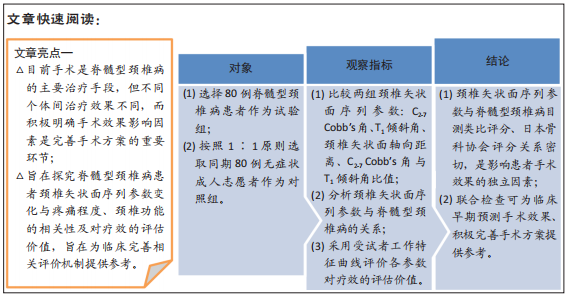
文题释义:
脊髓型颈椎病:是临床常见的造成脊髓功能障碍的病因之一,其早期无典型症状或仅存在颈部疼痛,随病情进展可致双下肢行走不稳、四肢麻木等。目前手术是脊髓型颈椎病的主要治疗手段,但临床长期实践发现,尽管均予以规范手术治疗但不同患者间的康复效果不尽相同,甚至有部分患者的症状未得到有效改善。因此,积极明确脊髓型颈椎病手术的影响因素对指导临床完善手术方案、确保患者获益具有重要作用。
脊柱矢状面序列:近年深入研究发现,脊髓型颈椎病与颈椎间盘退变及颈椎后凸进行性加重关系密切,基于此,学者们逐渐将脊柱矢状面序列与脊髓型颈椎病联系起来。此外,有研究表明,C2-7 Cobb’s角、T1倾斜角、颈椎矢状面轴向距离等颈椎区域重要影像学参数与患者生活质量相关。
背景:脊髓型颈椎病是由颈椎椎骨间连接结构退变而诱发,而颈椎矢状面序列参数可直接反映其退变情况,或可为临床评估病情及治疗效果提供参考。
目的:探究脊髓型颈椎病患者颈椎矢状面序列参数变化与疼痛程度、颈椎功能的相关性,并分析上述参数对临床疗效的评估价值。
方法:选取承德医学院附属医院2019年1月至2020年1月收治的80例脊髓型颈椎病患者作为试验组,按照1∶1原则选取同期80例无症状成人志愿者作为对照组,比较两组颈椎矢状面序列参数,包括C2-7 Cobb’s角、T1倾斜角、颈椎矢状面轴向距离、C2-7 Cobb’s角与T1倾斜角比值(C2-7/T1),分析颈椎矢状面序列参数与脊髓型颈椎病发生的关系。试验组随访6个月,根据日本骨科协会评分分为优良组(评分改善率≥50%)与非优良组(评分改善率< 50%),比较不同疗效患者的临床资料、手术前后疼痛目测类比评分、日本骨科协会评分、颈椎矢状面序列参数变化情况,分析颈椎矢状面序列参数与目测类比评分、日本骨科协会评分、疗效的相关性,采用受试者工作特征曲线评价各参数对疗效的评估价值。
结果与结论:①试验组C2-7 Cobb’s角、C2-7/T1小于对照组,T1倾斜角、颈椎矢状面轴向距离大于对照组(P < 0.05);C2-7 Cobb’s角、T1倾斜角、颈椎矢状面轴向距离、C2-7/T1与脊髓型颈椎病发生显著相关(P < 0.05);②疗效优良组与非优良组患者的压迫节段、手术方式、术前、术后1,6个月目测类比评分、日本骨科协会评分对比,差异有显著性意义(P < 0.05);③疗效优良组患者术前、术后1,6个月C2-7 Cobb’s角、C2-7/T1大于非优良组,T1倾斜角、颈椎矢状面轴向距离小于非优良组(P < 0.05);④目测类比评分与术前、术后1,6个月T1倾斜角、颈椎矢状面轴向距离呈正相关,与C2-7 Cobb’s角、C2-7/T1呈负相关;日本骨科协会评分与术前、术后1,6个月C2-7 Cobb’s角、C2-7/T1呈正相关,与T1倾斜角、颈椎矢状面轴向距离呈负相关(P < 0.05);⑤将压迫节段、手术方式等其他因素控制后,术前、术后1,6个月C2-7 Cobb’s角、T1倾斜角、颈椎矢状面轴向距离、C2-7/T1仍与疗效显著相关(P < 0.05);⑥术后6个月颈椎矢状面序列参数联合预测疗效的曲线下面积值为0.872,大于任一参数单独检查;⑦提示颈椎矢状面序列参数与脊髓型颈椎病患者目测类比评分、日本骨科协会评分关系密切,是影响此类患者手术效果的独立因素,联合检查可为临床早期评价修复效果、完善修复方案提供参考。
https://orcid.org/0000-0003-2270-8571 (曹胜)
中国组织工程研究杂志出版内容重点:人工关节;骨植入物;脊柱;骨折;内固定;数字化骨科;组织工程
中图分类号:
